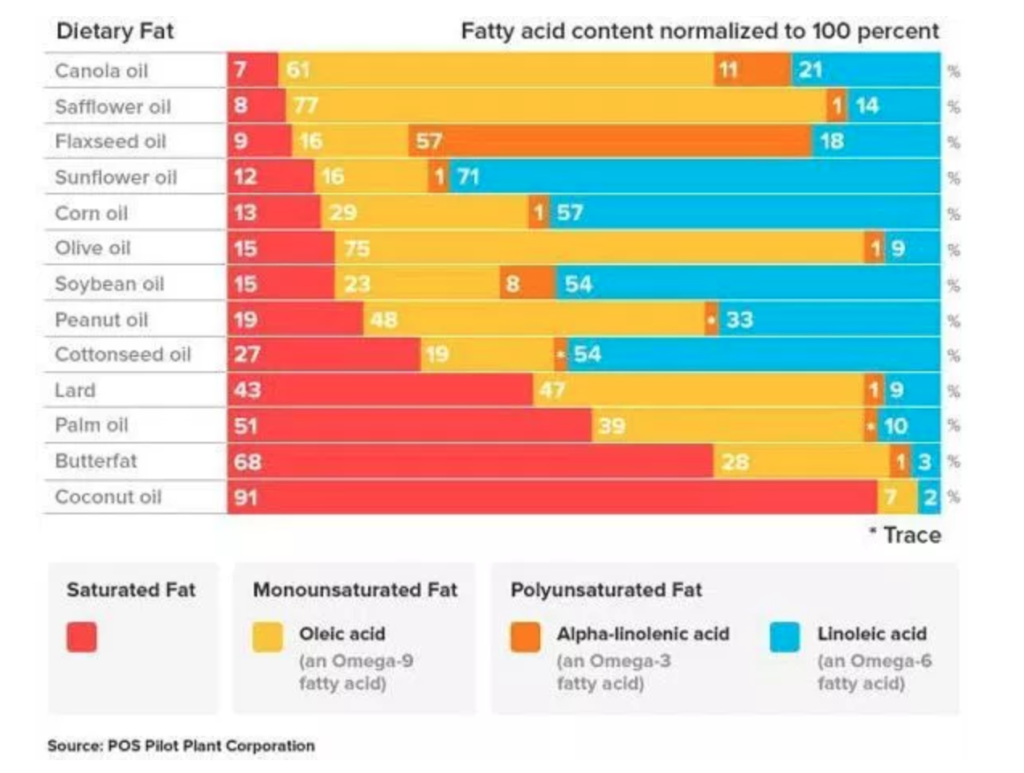Whats the difference between Omega 3, Omega 6 and Omega 9? Great question!
Firstly, who knew there were so many Omega’s. We usually only hear about Omega 3 but today I will break down all three for you. In a nutshell, it all comes down to the composition of each Omega, but lets explore a little further…
A quick recap on fat.
Before we begin, if you would like a more in depth understanding of fats in general – read this post. I will quickly highlight the main points however below.
There are two main types of fats – saturated and unsaturated. Saturated fats are unhealthy fats, eating greater amounts of saturated fat is linked with an increased risk of heart disease and high blood cholesterol levels. We want these in limited amounts in our diet. Unsaturated fats are healthy fats and are an important part of a healthy diet. These fats help reduce the risk of heart disease and lower cholesterol levels (among other health benefits) when they replace saturated fats in the diet.
There are two main types of unsaturated fats: polyunsaturated fats and monounsaturated fats.
Polyunsaturated fats:
- Omega-3 fats which are found in oily fish such as salmon, sardines and anchovies as well as walnuts, canola oil, soy products, flaxseeds and omega-3 enriched eggs.
- Omega-6 fats which are found in some oils such as safflower and soybean oil, along with some nuts, including brazil nuts.
Monounsaturated fats:
- Omega 9 fats which are found in olive and canola oil, avocados and avocado oil and some nuts, such as cashews and almonds.
Hence, when we are talking about Omega’s 3 & 6 we are referring to polyunsaturated fats and when we are talking about Omega 9 we are referring to a monounsaturated fat.
What is the main difference?
The main difference between a polyunsaturated fat and a monounsaturated fat is a slight difference in structure. Monounsaturated fats consist of a single double bond between two carbon atoms, a structure that keeps these fats liquid at room temperature. These fats are ‘non-essential’, meaning that they can be produced by the body.
Polyunsaturated fats consist of two or more double bonds within the carbon chain. These fats are ‘essential’, meaning that we must consume them as part of our diet, as the body cannot produce them. Hence, just like there are nine essential amino acids, there are two essential fatty acids that we must obtain through our diet: omega 3 and omega 6 fatty acids.

Let’s talk Omega 3.
Omega 3s are found in oily fish (e.g. sardines, salmon, herring, mackerel & anchovies), chia seeds, walnuts, hemp seeds, ground flaxseeds and algal products. Adequate consumption of Omega 3s ensures adequate cognition, foetal development, cardiovascular health and nerve functioning.
Once consumed, humans convert Omega 3s into longer chain fatty compounds called eicosapentaenoic acid (EPA) and docosahexaenoic acid (DHA). These are perhaps the two most known Omega 3 fatty acids, both of which offer an array of health benefits. EPA is a 20-carbon containing essential fatty acid that produces eicosanoids, which are especially good for reducing inflammation as well as mental health. DHA is a 22-carbon containing fatty acid, which constitutes around 8% of brain weight and therefore plays an important role in brain health and function and also shines in cardiovascular health.
Alpha-linolenic acid (ALA) is third polyunsaturated fat, that perhaps is slightly lesser known than the first two. It is an 18-carbon containing fatty acid can be converted into EPA and DHA, although the process, as some studies suggest, is not the most efficient. Thus, ALA is mainly used as an energy source for the body.
Let’s talk Omega 6.
Omega 6 fatty acids are primarily used for energy in the body and must be consumed through the diet through foods such as safflower and soybean oils, along with some nuts, such as brazil nuts and walnuts and some seeds such as pepitas.
The most known Omega 6 fatty acid is linoleic acid (LA), which similar to ALA, can be converted into longer Omega 6 fatty acid chains such as arachidonic acid (AA). AA can be used to produce eicosanoids, however, contrary to those produced by EPA, these one’s are more pro-inflammatory. AA acts as a building block for molecules the promote inflammation as well as constriction of blood vessels and blood clotting. But some molecules produced by AA also work to reduce inflammation and fight blood clots and promote cardiovascular health. Hence, these pro-inflammatory eicosanoids are important in our dietary intake, but in the right amounts. They play an important role in immunity and other roles as stated above, however, when too many are produced they can cause an inflammatory state.
In Western society, however, most people consume way too many Omega 6s which are found in foods such as margarine, vegetable oils, meats and so on. So much so that the Omega 6 to Omega 3 ratio is often 14-25:1. Just remember, in excessive amounts Omega 6s tend to promote inflammation whereas Omegas 3s work reduce inflammation. It is important to have both types, rather in balanced quantities.
The suggested ratio of Omega 6 to Omega 3 is 4:1 or less. The best way to keep this in check is by reducing your consumption of plant based oils high in Omega 6 fatty acids. These are highlighted in blue in the graph below (courtesy of Healthline).

As the graph shows, olive oil is perhaps the most balanced in terms of composition and there is much research to show it as beneficial to optimal health. Whilst coconut oil and butter are low in Omega 6 fatty acids, they are high in saturated fat, which can contribute to poor health when over consumed, hence, should be consumed in moderation. This isn’t to say not to consume them at all, they all do have a place, but you are best to mixing up your use of oils and fats, so you get a range of nutrients. Coconut oil itself is a topic of much hype in the nutrition world at the moment and I will cover more on it in coming posts.
Let’s talk Omega 9.
Omega 9 fatty acids are found in olive and canola oil, avocados and avocado oil, and some nuts, such as cashews, peanuts and almonds.
Oleic acid is perhaps the most well known Omega 9 fatty acid with its main sources being sunflower oil, canola oil and almonds. Being ‘non-essential’ is not necessary that Omega 9 fatty acids be obtained via the diet because the body has the ability to synthesise it from other things we eat.
Omega 9s can be beneficial in cardiovascular health, with science suggesting that it can work to lower LDL (‘bad’) cholesterol and increase HDL (‘good’) cholesterol.
Have something to say?
Comment below and feel free to share on all your platforms. As always, I would love to know your biggest takeaway – Tag us on Instagram @optima_health or #optimahealth. Thanks for reading x
Sources:
https://ods.od.nih.gov/factsheets/Omega3FattyAcids-Consumer/
https://www.healthline.com/nutrition/omega-3-6-9-overview#section3
Click to access Omega-3_6_and_9_Fats.pdf
https://www.drweil.com/vitamins-supplements-herbs/supplements-remedies/need-omega-9-fatty-acid/
